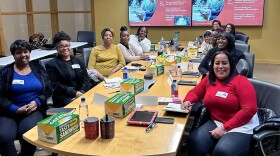An interactive exhibit showing how justice and equity shaped Connecticut neighborhoods is making its way along the shoreline.
The Practice of Democracy exhibit focuses on Bridgeport, New Haven and Norwalk.
April De Simone, an urban designer with a focus on intersectionality in architecture, sifted through historical documents and photographs pinpointing specific areas, movements and people to highlight as part of how the neighborhoods were shaped.
“Housing operates in a greater ecology,” De Simone said. “What the exhibit does is unpack that greater ecology through a curated history and narrative to understand, how did we get to the disparities and inequities today?”
The exhibit first opened in Bridgeport at Housatonic Community College in January. After about a month, the exhibit moved to New Haven, where it will remain at Gateway Community College until mid-April, before moving to Norwalk Community College through early June.
An art gallery lined with panels depicting life in New Haven from its inception to present day resides on the ground floor of Gateway Community College.
The exhibit features pictures from the mid-20th century showing New Haven residents outside their homes and the impact of Black Panthers in the Dixwell and Newhallville neighborhoods. Quotes from a Ku Klux Klan member who lived in the city are on display.
“This is the opportunity to walk through the kind of future they want to see within a framework that accentuates justice, equity and the value systems that we begin to instill in children at very, very early ages,” De Simone said.
Partway through the exhibit a table invites participants to place a thumbtack on the map of New Haven where they or a loved one lived and prompts placed throughout the exhibit promote discussion.
Some of the state’s community colleges were chosen as temporary homes for the exhibit as the Regional Plan Association (RPA), which works to promote livability and affordability in the tri-state area, had existing connections with the colleges.

RPA, along with The Housing Collective, the Connecticut Housing Finance Authority and several other housing advocacy groups, sponsored and contributed to the exhibit.
“There are a lot of people in Connecticut, as we’re having these conversations about the future of land use, zoning, housing affordability and public policy, who don't know or don't want to know how we got here,” RPA’s Connecticut Director Melissa Kaplan-Macey said. “They sort of hang on to this narrative of ‘I worked hard. People should work harder and you can live in my community too,’ without understanding how we got here.”
Norwalk’s beachfront neighborhoods are also a part of the exhibit.
A planning grant was given to De Simone for the project more than two years prior to the exhibit’s opening.





